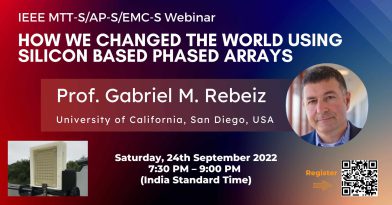
-
Saturday, September 24, 2022 7:30 pm - 9:00 pm(New Delhi Time) Add to my calendar
How We Changed the World Using Silicon Based Phased Arrays: Leaving Behind the Marconi Era and Entering the Directive Communications and Sensors Era for SATCOM, 5G and Imaging Radars
Prof. Gabriel M. Rebeiz
University of California, San Diego, USA
Abstract: Affordable phased-arrays, built using low-cost silicon, have become an essential technology for high data-rate terrestrial (5G) and satellite (SATCOM) systems to their high gain, electronically steerable patterns, narrow beamwidths, high tolerance to interference and adaptive nulling capabilities. They have also become the backbone of all LEO and MEO satellites both at the payload level and at the user-terminal. High EIRP, high-performance systems at X-band to W-band with analog and digital beamforming capabilities and with multiple beams, are now available at low-cost. These advances are reshaping our communication and radar/sensor systems, as we work to change our world from the Marconi-Era given by low-gain antenna systems to the Directive Communications Era where every antenna, every beam, every sensor is electronically steered. This talk summarizes our work in this area, present some amazing/unbelievable systems, and conclude with a roadmap for the future.
Speaker’s Bio: Prof. Gabriel M. Rebeiz is Member of the National Academy (elected for his work on phased-arrays) and is a Distinguished Professor and the Wireless Communications Industry Endowed Chair at the University of California, San Diego. He is an IEEE Fellow, and is the recipient of the IEEE MTT Microwave Prize (2000, 2014, 2020) all for phased-arrays. His 2×2 and 4×4 RF-beamforming architectures are now used by Renesas, ADI, NXP, Infineon, Sivers, Qualcomm, Intel, Samsung, Boeing and others, and most companies developing communication and radar systems. All SATCOM affordable phased-arrays are based on his work and architectures. He has published 900 IEEE papers with an h-index of 97 and graduated 116 PhD students.
They webinar is organized by IEEE MTT/AP/EMC Joint Chapter, Hyderabad Section.
This webinar is free to attend, but registration is mandatory. Please register now and add to your calendar to avoid last-minute hassles.